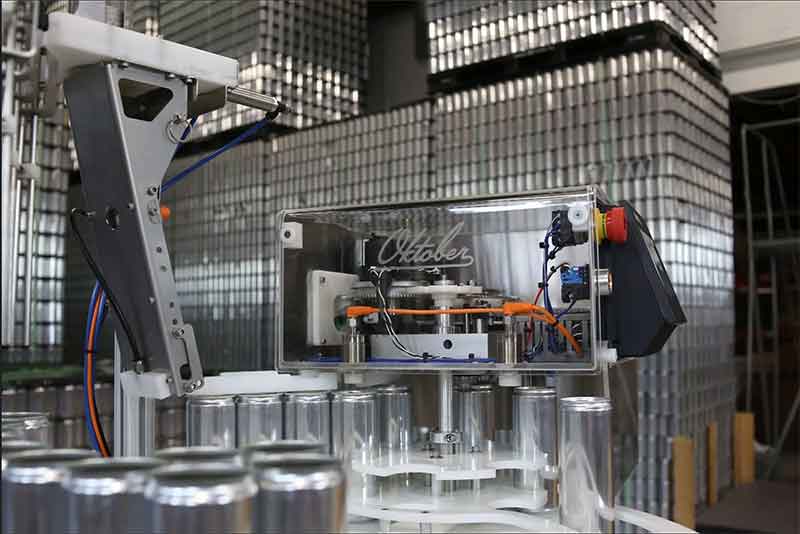
Without a doubt, aluminum cans have taken over the American craft beer market, showing signs of sustainable growth. A Fortune Business Insights report projects a 4.7% compound annual growth rate (CAGR) through 2027 from the global can market, with a high majority of that projected growth in the alcoholic beverage application. Recent reports by Future Market Insights (4.1% CAGR through 2035), Mordor Intelligence (3.5% CAGR through 2030), and DataM Intelligence (3.44% CAGR through 2031) also show an increase in the aluminum can market. Understanding these projections is why can seamer manufacturers, such as Oktober Can Seamers, are so pivotal in pushing the envelope to create cutting-edge equipment.
Oktober Can Seamers has been doing that for nearly a decade, creating several single-head seamers for commercial and homebrew setups. And now, the company is expanding its offerings with the Oktober Canning Line, a production-based seamer designed to produce nearly a case of beer per minute at an incredibly affordable cost.
According to the company, buyers will typically save thirty to forty percent, and sometimes more, in initial costs with the Oktober Canning Line compared to the average competitor, without compromising on quality or performance.
We chatted with Oktober Can Seamers Founder and Chief Executive Officer Dennis Grumm, who shared about the company’s origin story, what led to the creation of the Oktober Canning Line, the top three benefits of the equipment, what sets it apart, and just how fast you can get the return on your investment.
(Photography courtesy of Oktober Can Seamers)
What We’ll Cover in This Piece:
Affordable, Industry-Leading Brewery Software
What Is Oktober Can Seamers?
When Grumm, a craft beer enthusiast who also serves as a design engineer for the company, envisioned making a footprint in the craft beer industry in 2015, it was more along the lines of a B2C (Business-to-Consumer) model.
“We had the idea to make a single-head manual can seamer for homebrewers,” Grumm says. But then crowlers became all the rage. So when Oktober launched its online store in 2016, “We got into the crowler business as it was taking off and based the company on that until now.”
Grumm says can seamer designs date back to the early 1900s, but Oktober Can Seamers makes more modern adaptations.
The team, which started with three mechanical engineers with years of experience designing precision machines for the aerospace industry, designed and created several seamers.
Currently, the single-head seamers available include the Model 8 automatic can seamer, the Model 7 semi-manual can seamer, and the BenchMK seamer that runs by using an electric drill.
With rigorous design standards at a reasonable price point, Oktober Can Seamers quickly developed a loyal consumer base.
“Our machine is higher quality and less expensive,” Grumm says. “We’ve always been the lower-cost, newer-quality-machine option.”
As Oktober Can Seamers developed good relationships with customers, they established an open dialogue. Some partners started growing beyond the capabilities of the single-head crowler option.
They asked for more.
“They asked us to push it further,” Grumm says, explaining that after spiking during the “to-go” sales trend during COVID, interest in crowler machines has dipped a bit, with customers looking for different packages.
With the change in demand, Grumm says they began to shift gears.
About two years ago, Oktober Can Seamers started prototyping the Oktober Canning Line. Mainly because their “customers were asking for it!” says Grumm.
According to Grumm, thousands of Oktober Can Seamers’ customers do small production on crowler machines, around nine to eleven cans per minute. “I thought we could do something that gives them a step forward, and on a budget,” he says. “Make them able to grow.”
They launched the Oktober Canning Line this fall
What Are the Specs of the Oktober Canning Line?
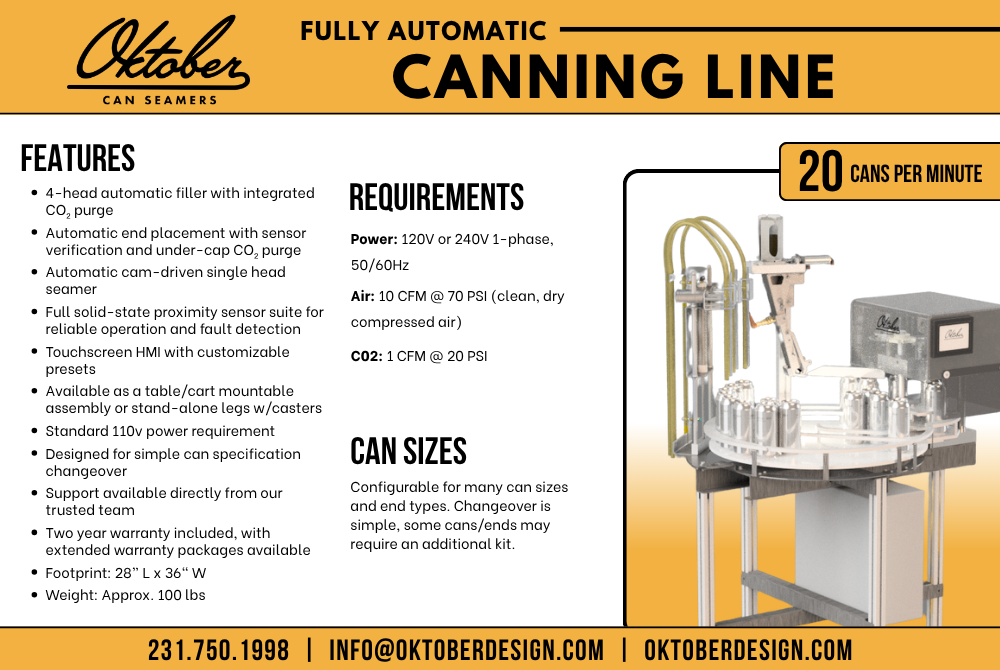
Graphic courtesy of Oktober Can Seamers
An automatic can seamer, the Oktober Canning Line features a four-head filler equipped with an integrated CO2 purge, as well as an automatic end placement with sensor verification and under-cap CO2 purge. It also features an automatic can-driven single-head seamer that can seam upwards of twenty cans per minute.
With the base model, cans must be manually placed on and removed from the machine. “So we made it modular, with a conveyor in and out, depalletizer, and rinser options to become available in the near future,” explains Grumm.
Depending on how much you intend to can, you can use the touchscreen to customize presets, including the number of filler heads you want to run. Grumm says they weren’t trying to reinvent the wheel with the machine, so it has many similar bells and whistles that other canning lines have, but he says they leaned into their experience to make a quality machine.
Grumm says this past June, they sold the first run of Oktober Canning Line machines to early adopters, ensuring they covered everything a brewery would want in a canning line.
“We are trying to nail it,” Grumm says. “It’s a very capable machine.”
Grumm understands things in the beverage industry can change quickly, so he says they specifically designed the Oktober Canning Line with “a huge window for capacity.” He adds, “Who knows what will be a trend or what people are looking for? We wanted it to be a capable machine down the road.”
The machine is designed for runs with cans as small as 100mL all the way up to 32-ounce crowlers and even large steel 401 cans for roasted coffee beans. The base unit fits standard 12-ounce and 16-ounce cans, as well as sleek cans—both the 7.5-ounce and 12-ounce sizes—with an accessory kit. The kit, Grumm says, is a simple reconfiguration adding rails to guide the cans.
Grumm says in addition to creating a quality product, his company always strives to sell the equipment at a price that won’t break the budget.
“I want to keep [the cost] down to set ourselves apart from the market,” he says. “It’s a newer product in a big way for us, so we want to see where it goes.”
Oktober says its system is priced at the low end of the market, yet offers the features, build quality, and support expected from higher-end lines. The price advantage comes from a years-long development process focused on rugged, simple engineering and in-house parts manufacturing, allowing Oktober Can Seamers to deliver professional-grade performance at a fraction of the cost.
What Are the Top Three Benefits of the Oktober Canning Line?
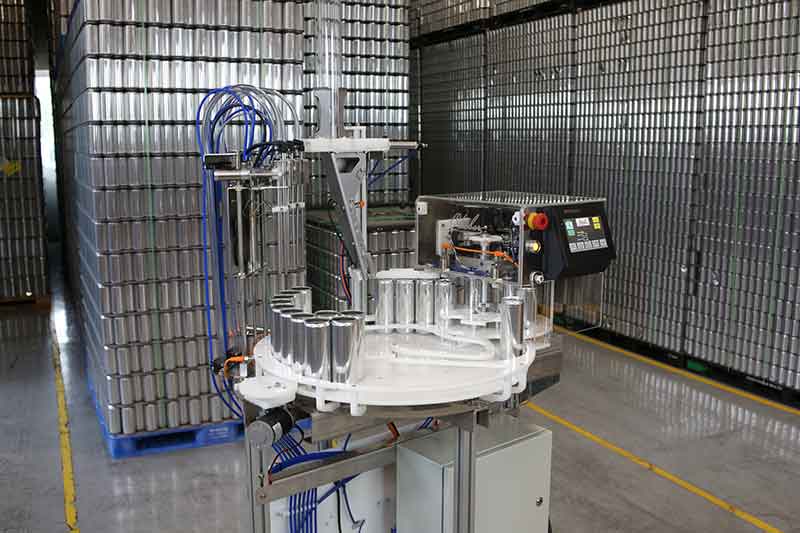
Photography courtesy of Oktober Can Seamers
Grumm points out three main benefits of the Oktober Canning Line: footprint, efficiency, and growth potential.
Footprint
The Oktober Canning Line has a footprint of 28 inches in length and 36 inches in width, weighs approximately 100 pounds, and runs on standard 110V power.
“It’s tiny!” says Grumm of the two-and-a-quarter-feet-long by three-feet-wide machine. “People will appreciate this the most.”
Efficiency
This machine cranks out twenty cans per minute. So, just four cans shy of a case, which is impressive.
“The machine can do that all day long,” shares Grumm.
He says that the canning rate applies to 12-ounce cans, too, with the caveat that it could reach that capacity with 16-ounce cans if the beverage isn’t foamy.
Growth Potential
The Oktober Canning Line, as mentioned above, is modular, which lends to Grumm’s third benefit: “Long-term capability.”
“We have a number of add-ons in the works,” Grumm says, noting the possibility of using an insert for the cans to be loaded, a depalletizer, as well as variable can sizes, among others. “Our mantra allows customers to be light on their feet. You think one beer can be good in sixteen ounces instead of twelve? [With this machine], you don’t have to spend more to make that happen.”
What Sets the Oktober Canning Line Apart From Others?
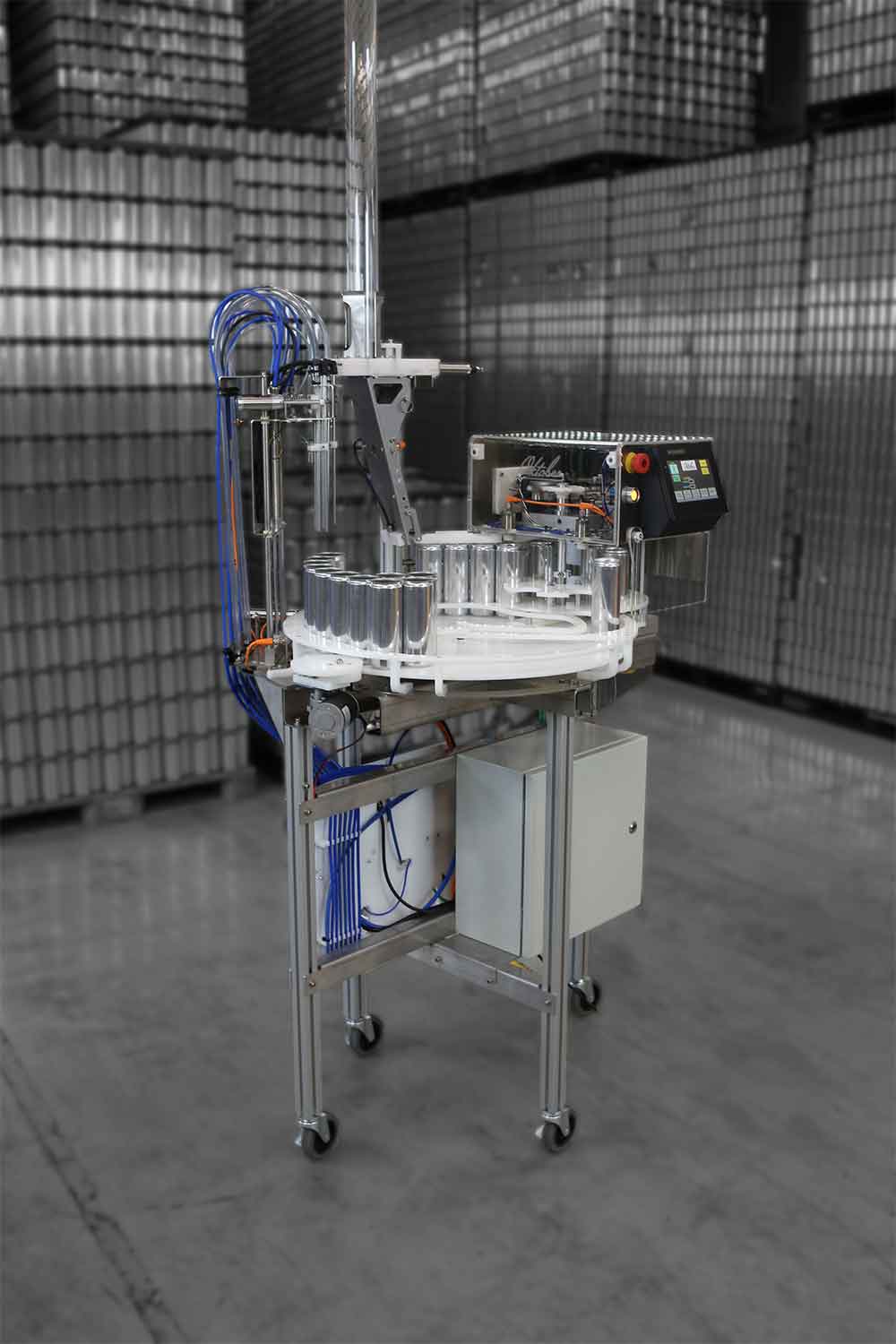
Photography courtesy of Oktober Can Seamers
Grumm says the Oktober Canning Line, part for part, is no different than any other machine. So what sets it apart?
“It is a good, solid design. And you can still improve it in a lot of ways,” he says. “It uses the best parts and pieces to make it a reliable machine.”
He says a filler is just a filler. The rotary table used in his machine is nothing groundbreaking that hasn’t been seen in automation and food processing.
“It’s just a simple, reliable, thoroughly designed machine, and that’s what I like about it,” Grumm says, pointing to the simplicity of the all-mechanical seamer drive that is part of the Oktober Canning Line. “That’s better than a bunch of sensor stuff.”
He adds, “This is our first fully automated production canning solution, designed for craft beverage makers who value simplicity, reliability, and scale. We’ve kept it true to our motto: ‘Everything you need, nothing you don’t.’”
How Quickly Can You See ROI on the Oktober Canning Line?
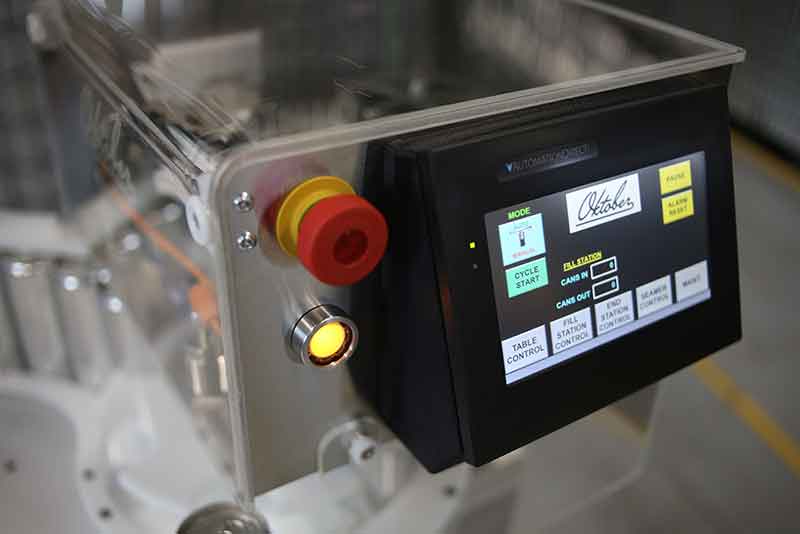
Photography courtesy of Oktober Can Seamers
When investing in equipment, any business would quickly wonder how long it will take for the company to recoup its investment.
When asked, Grumm quickly spouted off some numbers, saying that in an eight-hour shift, the machine could crank out 9,600 cans. But with breaks and other setups, he assumed 6,000 cans.
Grumm lays out a hypothetical: Say you sell those 6,000 cans for $3 a piece for a $12 four-pack, that’s $18,000 in potential revenue.
“You can theoretically pay this off in two days of running it,” says Grumm with a laugh.
He adds another reference point.
“If you compare this to our crowler machine, many of our customers have said they paid theirs back in a couple of weeks to a month,” he says. “When you look at the price point [of our machine], it might be a little longer than that, but not much.”
Are You Ready for a Canning Line Upgrade?
Despite its compact footprint, the modular Oktober Canning Line is suitable for beverage companies of all sizes.
“This machine can work in the smallest places, as small as a crowler machine, to having a room full of these,” Grumm says. “It could pretty much fit into all the craft beer sectors. It’s a possible way of doing a million cans a month.”
If you’re looking to start canning more or add on to your current operation, Grumm encourages breweries to reach out for more information. Call (231) 750-1998 or email [email protected].



